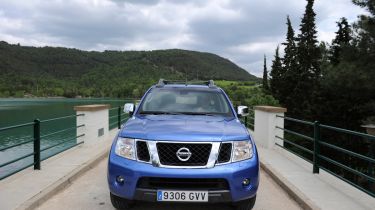Nissan Navara 3.0 V6 Tekna
Trusty workhorse from Japanese brand gets facelifted, and we're first to get behind the wheel.

The Navara is a seriously solid, proven and dependable workhorse that will lug large loads on and off the beaten track. Its appeal is increased by the comfortable cabin, making it a genuine proposition for private buyers with active lifestyles. However, the car is one of the last of a dying breed – its old-fashioned heavyweight chassis is losing the battle against ever-stricter CO2 and crash regulations, and thus hampers its showroom appeal. The lnumber of compromises you make in terms of dynamics, comfort and finance mean that this is a car you only buy if you absolutely have to. But for those who need a robust pick-up, only a Navara will do.
It’s time for a mid-life pick-me-up for Nissan’s trusty Navara. The utilitarian workhorse is Europe’s best-selling pick-up, but that hasn’t stopped the Japanese firm giving it a range of upgrades to make sure it remains at the top of the sales charts. Auto Express is first behind the wheel to see if the revisions hit the spot.
The Navara has been around since 2005 and is built in the same factory as the Pathfinder SUV, which has also been upgraded. Both cars use the same ladder frame chassis which is suited to their rugged character. The key advantages of retaining these underpinnings, instead of opting for a more modern and refined monocoque, are simplicity and strength. This means that as well as coping with off-road terrain, thanks to its switchable four-wheel-drive, the Navara can lug a load of up to 1,090kg, and tow a 3,000kg trailer when fitted with the new 3.0-litre V6 diesel.
To mark out the latest Navara, there’s a new front bumper, bonnet and grille which extends the length of the nose by 8cm. Despite not being radical changes to the Tonka-toy looks, the rounded bumper is more aerodynamic, benefiting fuel consumption. New 18-inch alloy wheels, and the option of the striking Electric Blue paint applied to our test car, complete the tweaks.
In contrast to its rugged exterior, the interior is surprisingly luxurious. Three in four of the 4,000 Navaras sold per year in the UK are specced in range-topping Tekna trim, which includes heated leather seats which have redesigned backs for better support on long journeys. The switchgear includes big, easy to use buttons and chunky indicator stalks, while cruise control now features a speed limiter.
Our car featured the optional Nissan Connect Premium system, which includes a hard-disk-based sat-nav and Bose stereo, as well as a reversing camera, which is useful when manoeuvring in tight spaces.
Under the bonnet, power is provided by a choice of 2.5-litre four-cylinder or new Renault-Nissan Alliance-developed 3.0-litre V6 diesels. Our car was equipped with the latter, which has been engineered for refinement and power, so the unit idles at just 650rpm, while its peak 550Nm of torque comes in at a low 1,700rpm. The truck weighs over two tonnes, which was supplemented by 225kg of stone chips which Nissan had added to the launch cars, but the engine coped well with the truck’s weight. The unit is only available with the seven-speed auto gearbox found in the sporty 370Z, albeit with revised ratios. The box shifts quite smoothly, but is often caught out by gradients in the road, and takes some time to find the right gear.
The switchable four-wheel drive means that the Navara is mostly rear driven on the road. But there’s a low range transfer box which gives the truck ample off-road ability. The low-geared steering takes some getting used to, but the handling is quite good given the car’s size, plus the added stone in the rear of our test car. However, the downside of the car’s simple ladder frame chassis is that the leaf-sprung rear suspension is fidgety, especially over expansion gaps on the motorway. The chassis also transmits vibrations through the cabin, steering wheel and pedals, which can get tiring on longer drives. And while body roll isn’t too much of an issue for the driver, who has the steering wheel to hold on to, the amount of lean in corners is likely to give passengers an uncomfortable ride. Wind noise and road roar from the tyres is pronounced too.
As you’d expect, the larger diesel is more refined and powerful than the four-cylinder unit, and also uses more fuel. But unlike the smaller unit, the V6 has to be serviced annually or every 12,000 miles, rather than every two years or 18,000 miles, which will bump up the running costs.
Rival – Mitsubishi L200
The Navara is Europe’s favourite pick-up, but the L200 is the king of the road in the UK. It’s out-brawned by the newcomer’s engine, meaning the Mitsubishi towing weight is limited to a still-impressive 2,700kg. But the L200 fights back with a much cheaper purchase price, cleaner engines and well-specced interiors.







